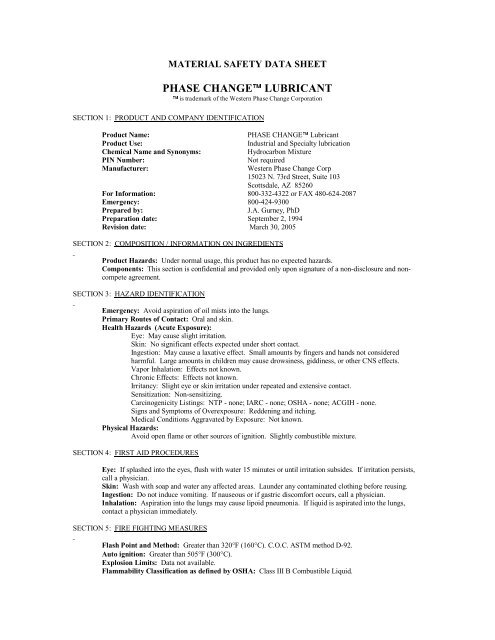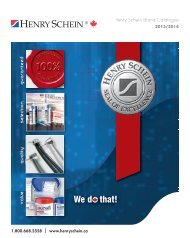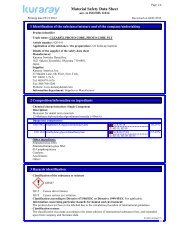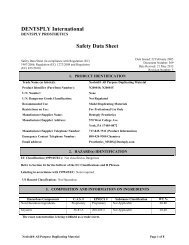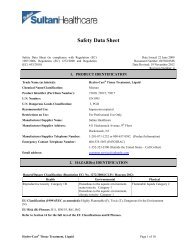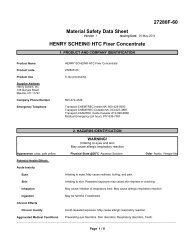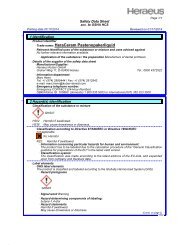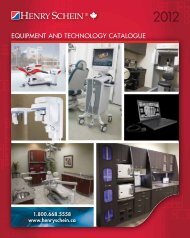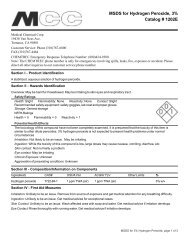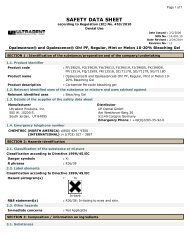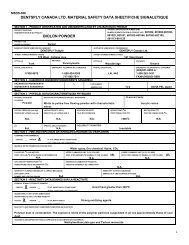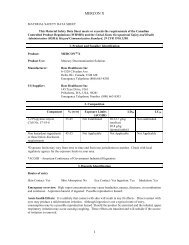PHASE CHANGE⢠LUBRICANT - Henry Schein
PHASE CHANGE⢠LUBRICANT - Henry Schein
PHASE CHANGE⢠LUBRICANT - Henry Schein
You also want an ePaper? Increase the reach of your titles
YUMPU automatically turns print PDFs into web optimized ePapers that Google loves.
MATERIAL SAFETY DATA SHEET<strong>PHASE</strong> CHANGE <strong>LUBRICANT</strong> is trademark of the Western Phase Change CorporationSECTION 1: PRODUCT AND COMPANY IDENTIFICATIONCHANGE Product Name:<strong>PHASE</strong> LubricantProduct Use:Industrial and Specialty lubricationChemical Name and Synonyms:Hydrocarbon MixturePIN Number:Not requiredManufacturer:Western Phase Change Corp15023 N. 73rd Street, Suite 103Scottsdale, AZ 85260For Information: 800-332-4322 or FAX 480-624-2087Emergency: 800-424-9300Prepared by:J.A. Gurney, PhDPreparation date: September 2, 1994Revision date: March 30, 2005SECTION 2: COMPOSITION / INFORMATION ON INGREDIENTSProduct Hazards: Under normal usage, this product has no expected hazards.Components: This section is confidential and provided only upon signature of a non-disclosure and noncompeteagreement.SECTION 3: HAZARD IDENTIFICATIONEmergency: Avoid aspiration of oil mists into the lungs.Primary Routes of Contact: Oral and skin.Health Hazards (Acute Exposure):Eye: May cause slight irritation.Skin: No significant effects expected under short contact.Ingestion: May cause a laxative effect. Small amounts by fingers and hands not consideredharmful. Large amounts in children may cause drowsiness, giddiness, or other CNS effects.Vapor Inhalation: Effects not known.Chronic Effects: Effects not known.Irritancy: Slight eye or skin irritation under repeated and extensive contact.Sensitization: Non-sensitizing.Carcinogenicity Listings: NTP - none; IARC - none; OSHA - none; ACGIH - none.Signs and Symptoms of Overexposure: Reddening and itching.Medical Conditions Aggravated by Exposure: Not known.Physical Hazards:Avoid open flame or other sources of ignition. Slightly combustible mixture.SECTION 4: FIRST AID PROCEDURESEye: If splashed into the eyes, flush with water 15 minutes or until irritation subsides. If irritation persists,call a physician.Skin: Wash with soap and water any affected areas. Launder any contaminated clothing before reusing.Ingestion: Do not induce vomiting. If nauseous or if gastric discomfort occurs, call a physician.Inhalation: Aspiration into the lungs may cause lipoid pneumonia. If liquid is aspirated into the lungs,contact a physician immediately.SECTION 5: FIRE FIGHTING MEASURESFlash Point and Method: Greater than 320°F (160°C). C.O.C. ASTM method D-92.Auto ignition: Greater than 505°F (300°C).Explosion Limits: Data not available.Flammability Classification as defined by OSHA: Class III B Combustible Liquid.
Combustion Products: Combustion will produce carbon dioxide and/or carbon monoxide, sulfur dioxideand possibly phosgene.Extinguishing Media: Water fog, carbon dioxide, dry chemical, foam.Unusual Fire and Explosion Hazard: Spills can be slippery. Take care to secure adequate footing.Special Precautions: Avoid streams of water as this may serve to spread burning liquid. Stay upwind of afire. Smoke may be dark and dense.Fire-Fighting Equipment: Use self-contained breathing apparatus (SCBA) in any enclosed area. Useappropriate protective equipment such as bunker gear.SECTION 6: ACCIDENTAL RELEASE MEASURESProcedures for clean-up:For small spills: Wipe up and dispose in a suitable waste container.Personal Protection: No special requirements. Spills to smooth, hard surfaces may be veryslippery. Take care with footing.Environmental Precautions: Avoid discharge to sewers and public waterways.SECTION 7: HANDLING AND STORAGESafe Handling and Hygienic Practices: Control oil mists through a vacuum aspirator and/or adequateventilation. Normal usage amounts not expected to cause a hazard.Storage Requirement: In well-closed containers to avoid prolonged air contact. Keep away from children.SECTION 8: EXPOSURE CONTROLSEngineering Controls: No special requirements except to control oil mists below established limits.Personal Protection: Good handling practices should be sufficient.Ventilation: Use local mechanical ventilation where needed to avoid any oil mist.Respiratory: No special equipment requirements under normal conditions.Eye Protection: Not normally required. Safety glasses under splashing conditions.Gloves: Not required.Ingestion: Do not ingest.Exposure Limit Guidelines: PEL 5mg/M 3 , STEL 10mg/M 3 for oil mists.SECTION 9: PHYSICAL AND CHEMICAL PROPERTIESAppearance and odor: Pale yellow and clear color. Light walnut odor.Physical state: Mobile liquid.pH of Concentrate: Not applicable.Vapor Pressure: < 0.1 mm (Estimated)Vapor Density: (Air=1) > 1 (Estimated)Specific Gravity: 0.87Solubility in Water: Negligible.Boiling Point: > 446°F (230°C) (Estimated)Viscosity: 78 to 90 SUS (Estimated)Evaporation Rate: (Butyl Acetate = 1) Not applicable.Percent Volatile: Data not available.SECTION 10: STABILITY AND REACTIVITYStability: Stable.Conditions to avoid: Avoid high heat and ignition sources.Incompatibility: Avoid contact with strong oxidizing agents such as pure oxygen and chlorine.Hazardous Decomposition: Will not occur.Hazardous Polymization: Will not occur.SECTION 11: TOXICITY INFORMATIONAcute Data: Rat-oral LD 50 : >5000 mg/kg.Information for this MSDS based on component data and manufacturing experience.SECTION 12: ECOLOGICAL INFORMATION
This product has a low probability of toxic environmental impact.SECTION 13: DISPOSAL CONSIDERATIONSRCRA Characteristics: This product has been evaluated under the RCRA criteria and is not considered ahazardous waste in its purchased form.Volatile Organic Compound (VOC) Content: Does not contain volatile organic compounds as defined bythe California Air Resources Board (CARB).Special Instructions: Small amounts do not have any special requirements.SECTION 14: TRANSPORT INFORMATIONDOT Labeling: Not required.Proper shipping: Not required.Hazard Class: Not required.Identification Number: Not required.SECTION 15: REGULATORY INFORMATIONOSHA Compliance: This MSDS prepared in accordance with 29CFR1910.1200 and the ANSI 2 400.1Standard for the preparation of Material Safety Data Sheets (MSDS). Also drawn to meet the WHMISstandards according to Section 13(a) and 14(a) of the Hazardous Products Act and Part I of the ControlledProducts Regulations.TSCA: Although components of this product find listing under the Toxic Substances Control Act (TSCA),this blended product requires no import or export declarations.SARA Title III: The product in its purchased form is not regulated under the SARA hazard categories ofSections 311 and 312 of the Superfund Amendment and the Reauthorization Act of 1986 (SARA Title III).CERCLA (Superfund), State and Local Planning (Reportable Quantities): Not required.State Right-to-Know Compliance:California: Not required.Massachusetts: Not required.New Jersey: Not required.Pennsylvania: Not required.SECTION 16: OTHER INFORMATIONHazard Rating:Health: 0No significant health effects.Flammability: 1Combustibility.Reactivity: 0 Not considered reactive under fire conditions. Does notreact with water.BASED ON THE NFPA 704 STANDARD:RatingHazard4 Extreme3 Severe, Damage2 Moderate1 Slight0 None


